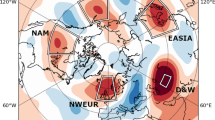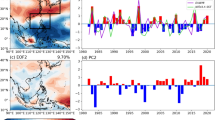Abstract
Observational evidence showed that the leading mode of precipitation variability over the tropical Pacific during boreal spring experienced a pronounced interdecadal change around the late 1990s, characterized by a precipitation pattern shift from an eastern Pacific (EP) type to a central Pacific (CP) type. The distinct impacts of such a precipitation pattern shift on the extratropical atmospheric teleconnection were examined. An apparent poleward teleconnection extending from the tropics to the North Atlantic region was observed after 1998, while, there was no significant teleconnection before 1998. To understand why only the CP–type precipitation mode is associated with a striking atmospheric teleconnection after 1998, diagnostic analyses with the Eliassen–Palm flux and Rossby wave source (RWS) based on the barotropic vorticity equation were performed. The results show that for the EP–type precipitation mode, no significant RWS anomalies appeared over the subtropical Pacific due to the opposite effect of the vortex stretching and absolute vorticity advection processes. For the CP–type precipitation mode, however, there are both significant vorticity forcing source over the subtropical CP and clear poleward–propagation of Rossby wave. The spatial distribution of the CP–type precipitation pattern tends to excite a conspicuous anomalous southerly and a well–organized negative vorticity center over the subtropical CP where both the mean absolute vorticity gradient and mean divergence flow are large, hence, the interaction between the heating–induced anomalous circulation and the basic state made the generation of Rossby waves conceivable and effective. Such corresponding teleconnection responses to the prescribed heating were also examined by using a Linear Baroclinic Model (LBM). It turned out that significant poleward teleconnection pattern is only caused by the CP–type precipitation mode, rather than by the EP–type precipitation mode. Further sensitive experiments demonstrated that the change in spring basic state before and after 1998 played a relatively minor role in exciting such a teleconnection pattern, when compared with the tropical precipitation anomaly pattern change.












Similar content being viewed by others
References
Adler RF, Huffman GJ, Chang A et al (2003) The Version-2 global precipitation climatology project (GPCP) monthly precipitation analysis (1979–Present). J Hydrometeorol 4:1147–1167. https://doi.org/10.1175/1525-7541(2003)004<1147:TVGPCP>2.0.CO;2
Ashok K, Behera SK, Rao SA et al (2007) El Niño Modoki and its possible teleconnection. J Geophys Res Ocean 112:1–27. https://doi.org/10.1029/2006JC003798
Black RX, Dole RM (1993) The dynamics of large-scale cyclogenesis over the North Pacific Ocean. J Atmos Sci 50:421–442. https://doi.org/10.1175/1520-0469(1993)050<0421:TDOLSC>2.0.CO;2
Cai W, Cowan T (2009) La Niña Modoki impacts Australia autumn rainfall variability. Geophys Res Lett 36:9–12. https://doi.org/10.1029/2009GL037885
Chen Z, Du Y, Wen Z et al (2017) Indo-Pacific climate during the decaying phase of the 2015/16 El Niño: role of southeast tropical Indian Ocean warming. Clim Dyn. https://doi.org/10.1007/s00382-017-3899-z
Chu C, Yang XQ, Ren X, Zhou T (2013) Response of Northern Hemisphere storm tracks to Indian-western Pacific Ocean warming in atmospheric general circulation models. Clim Dyn 40:1057–1070. https://doi.org/10.1007/s00382-013-1687-y
Chu C, Yang X-Q, Sun X et al (2017) Effect of the tropical Pacific and Indian Ocean warming since the late 1970s on wintertime Northern Hemispheric atmospheric circulation and East Asian climate interdecadal changes. Clim Dyn 22:1–18
Chung P-H, Li T (2013) Interdecadal relationship between the mean state and El Niño types. J Clim 26:361–379. https://doi.org/10.1175/JCLI-D-12-00106.1
Dee DP, Uppala SM, Simmons AJ et al (2011) The ERA-Interim reanalysis: configuration and performance of the data assimilation system. Q J R Meteorol Soc 137:553–597. https://doi.org/10.1002/qj.828
Feng J, Li J (2011) Influence of El Niño Modoki on spring rainfall over south China. J Geophys Res Atmos 116:1–10. https://doi.org/10.1029/2010JD015160
Feng J, Chen W, Tam CY, Zhou W (2011) Different impacts of El Niño and El Niño Modoki on China rainfall in the decaying phases. Int J Climatol 31:2091–2101. https://doi.org/10.1002/joc.2217
Guo Y, Wen Z, Wu R et al (2015) Impact of tropical Pacific precipitation anomaly on the East Asian upper-tropospheric westerly jet during the boreal winter. J Clim 28:6457–6474. https://doi.org/10.1175/JCLI-D-14-00674.1
Guo Y, Wen Z, Wu R (2016) Interdecadal change in the tropical pacific precipitation anomaly pattern around the late 1990s during boreal spring. J Clim 29:5979–5997. https://doi.org/10.1175/JCLI-D-15-0462.1
Guo Y, Ting M, Wen Z, Lee DE (2017) Distinct patterns of tropical Pacific SST anomaly and their impacts on North American climate. J Clim 30:5221–5241. https://doi.org/10.1175/JCLI-D-16-0488.1
Horel JD, Wallace JM (1981) Planetary-scale phenomena associated with the Southern Oscillation. Mon Weather Rev 109:813–829
Hoskins BJ, Ambrizzi T (1993) Rossby wave propagation on a realistic longitudinally varying flow. J Atmos Sci 50:1661–1671
Hoskins BJ, Karoly DJ (1981) The steady linear response of a spherical atmosphere to thermal and orographic forcing. J Atmos Sci 38:1179–1196
Jacox MG, Hazen EL, Zaba KD et al (2016) Impacts of the 2015–2016 El Niño on the California current system: early assessment and comparison to past events. Geophys Res Lett 43:7072–7080. https://doi.org/10.1002/2016GL069716
Jia X, Wang S, Lin H, Bao Q (2015) A connection between the tropical Pacific Ocean and the winter climate in the Asian–Pacific region. J Geophys Res Atmos 120:430–448. https://doi.org/10.1002/2014JD022324
Jo H-S, Yeh S-W, Lee S-K (2015) Changes in the relationship in the SST variability between the tropical Pacific and the North Pacific across the 1998/99 regime shift. Geophys Res Lett 42:7171–7178. https://doi.org/10.1002/2015GL065049
Johnson NC, Kosaka Y (2016) The impact of eastern equatorial Pacific convection on the diversity of boreal winter El Niño teleconnection patterns. Clim Dyn 47:3737–3765. https://doi.org/10.1007/s00382-016-3039-1
Kosaka Y, Nakamura H (2006) Structure and dynamics of the summertime Pacific–Japan teleconnection pattern. Q J R Meteorol Soc 132:2009–2030. https://doi.org/10.1256/qj.05.204
Lim YK, Kovach RM, Pawson S, Vernieres G (2017) The 2015/16 El Niño event in context of the MERRA-2 reanalysis: a comparison of the tropical pacific with 1982/83 and 1997/98. J Clim 30:4819–4842. https://doi.org/10.1175/JCLI-D-16-0800.1
Lin H, Derome J (1997) On the modification of the high- and low-frequency eddies associated with the PNA anomaly: an observational study. Tellus Ser A Dyn Meteorol Oceanogr 49:87–99. https://doi.org/10.3402/tellusa.v49i1.12213
Lin H, Derome J (2004) Nonlinearity of the extratropical response to tropical forcing. J Clim 17:2597–2608. https://doi.org/10.1175/1520-0442(2004)017<2597:NOTERT>2.0.CO;2
Lu R, Kim B-J (2004) The climatological Rossby wave source over the STCZs in the summer northern hemisphere. J Meteorol Soc Japan 82:657–669. https://doi.org/10.2151/jmsj.2004.657
Lu R, Lin Z (2009) Role of subtropical precipitation anomalies in maintaining the summertime meridional teleconnection over the western North Pacific and East Asia. J Clim 22:2058–2072. https://doi.org/10.1175/2008JCLI2444.1
McBride JL, Haylock MR, Nicholls N (2003) Relationships between the maritime continent heat source and the El Niño-Southern oscillation phenomenon. J Clim 16:2905–2914. https://doi.org/10.1175/1520-0442(2003)016<2905:RBTMCH>2.0.CO;2
Paek H, Yu JY, Qian C (2017) Why were the 2015/2016 and 1997/1998 extreme El Niños different? Geophys Res Lett 44:1848–1856. https://doi.org/10.1002/2016GL071515
Park J-H, An S-I (2014) The impact of tropical western Pacific convection on the North Pacific atmospheric circulation during the boreal winter. Clim Dyn 43:2227–2238. https://doi.org/10.1007/s00382-013-2047-7
Peng S, Whitaker JS (1999) Mechanisms determining the atmospheric response to midlatitude SST anomalies. J Clim 12:1393–1408. https://doi.org/10.1175/1520-0442(1999)012<1393:MDTART>2.0.CO;2
Plumb RA (1985) On the three-dimensional propagation of stationary waves. J Atmos Sci 42:217–229
Rayner NA, Parker DE, Horton EB et al (2003) Global analyses of sea surface temperature, sea ice, and night marine air temperature since the late nineteenth century. J Geophys Res 108:4407. https://doi.org/10.1029/2002JD002670
Sardeshmukh PD, Hoskins BJ (1988) The generation of global rotational flow by steady idealized tropical divergence. J Atmos Sci 45:1228–1251
Shimizu MH, de Cavalcanti IFA (2011) Variability patterns of Rossby wave source. Clim Dyn 37:441–454. https://doi.org/10.1007/s00382-010-0841-z
Taschetto AS, England MH (2009) El Niño Modoki Impacts on Australian Rainfall. J Clim 22:3167–3174. https://doi.org/10.1175/2008JCLI2589.1
Wallace JM, Gutzler DS (1981) Teleconnections in the geopotential height field during the northern hemisphere winter. Mon Weather Rev 109:784–812
Wang J, Wen Z, Wu R et al (2016) The mechanism of growth of the low-frequency East Asia–Pacific teleconnection and the triggering role of tropical intraseasonal oscillation. Clim Dyn 46:3965–3977. https://doi.org/10.1007/s00382-015-2815-7
Watanabe M, Kimoto M (2000) Atmosphere–ocean thermal coupling in the North Atlantic: a positive feedback. Q J R Meteorol Soc 126:3343–3369. https://doi.org/10.1002/qj.49712657017
Webster PJ, Chang H-R (1998) Atmospheric wave propagation in heterogeneous flow: basic flow controls on tropical—extratropical interaction and equatorial wave modification. Dyn Atmos Ocean 27:91–134. https://doi.org/10.1016/S0377-0265(97)00003-1
Weng H, Behera SK, Yamagata T (2009) Anomalous winter climate conditions in the Pacific rim during recent El Niño Modoki and El Niño events. Clim Dyn 32:663–674. https://doi.org/10.1007/s00382-008-0394-6
Wu B, Zhou T, Li T et al (2012) Two distinct modes of tropical indian ocean precipitation in boreal winter and their impacts on equatorial Western Pacific. J Clim 25:921–938. https://doi.org/10.1175/JCLI-D-11-00065.1
Yoo C, Lee S, Feldstein SB (2012) Mechanisms of arctic surface air temperature change in response to the Madden–Julian oscillation. J Clim 25:5777–5790. https://doi.org/10.1175/JCLI-D-11-00566.1
Yu B, Zwiers FW (2007) The impact of combined ENSO and PDO on the PNA climate: A 1000-year climate modeling study. Clim Dyn 29:837–851. https://doi.org/10.1007/s00382-007-0267-4
Zheng J, Liu Q, Wang C, Zheng XT (2013) Impact of heating anomalies associated with rainfall variations over the Indo–Western Pacific on Asian atmospheric circulation in winter. Clim Dyn 40:2023–2033. https://doi.org/10.1007/s00382-012-1478-x
Acknowledgements
This research was jointly supported by National Key Research and Development Program of China (2016YFA0600601), National Natural Science Foundation of China (41530503, 41621005, 41775043 and 41605027) and Research Projects of Public Welfare Meteorological Industry in China (201406001).
Author information
Authors and Affiliations
Corresponding author
Rights and permissions
About this article
Cite this article
Guo, Y., Wen, Z., Chen, R. et al. Effect of boreal spring precipitation anomaly pattern change in the late 1990s over tropical Pacific on the atmospheric teleconnection. Clim Dyn 52, 401–416 (2019). https://doi.org/10.1007/s00382-018-4149-8
Received:
Accepted:
Published:
Issue Date:
DOI: https://doi.org/10.1007/s00382-018-4149-8




